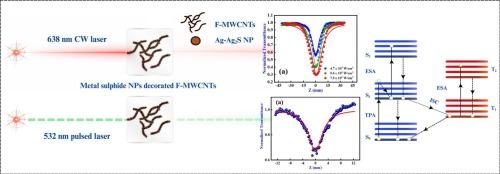Ag–Ag2S decorated functionalized MWCNTs nanocomposite: A highly efficient optical limiter
IF 5.1
3区 材料科学
Q2 MATERIALS SCIENCE, COATINGS & FILMS
引用次数: 0
Abstract
Sensitive optical devices require robust protection from intense laser light; however, no single material has fully satisfied this need. In this study, a novel nanocomposite was synthesized by decorating functionalized multi-walled carbon nanotubes (F-MWCNTs) with Ag-Ag2S alloy nanoparticles (AS NPs) using the hydrothermal method, aiming to enhance optical limiting performance. The nanocomposite's structure was confirmed using standard spectroscopic and microscopic techniques. Nonlinear optical measurements were carried out using a continuous wave (CW) laser with 638 nm wavelength via a Z-scan technique and using nanosecond laser pulses with 532 nm wavelength via a Z-scan and degenerate four-wave mixing (DFWM) techniques. Nonlinear optical measurements reveal a nonlinear absorption coefficient, derived from open-aperture (OA) Z-scan fits at three CW intensities (4.7, 5.6, and 6.5 × 103 Wcm−2), where the nonlinear optical absorption coefficient (βeff) increases from (4.4 ± 0.2) × 10−3 to (10.5 ± 0.5) × 10−3 cmW−1. This intensity-dependent growth reflects a sequential 2PA → ESA (RSA-assisted) mechanism rather than material instability, and the values significantly surpass those of previously reported materials. This enhanced performance demonstrates the potential of F-MWCNTs-based nanocomposites for advanced optical limiting applications, paving the way for improved protection of sensitive photonic devices.

Ag-Ag2S修饰功能化MWCNTs纳米复合材料:一种高效的光学限制器
敏感的光学设备需要强大的保护,以防止强激光;然而,没有一种材料能完全满足这一需求。本研究采用水热法制备了Ag-Ag2S合金纳米颗粒(AS NPs)修饰功能化多壁碳纳米管(F-MWCNTs),以提高其光学限制性能。采用标准光谱学和显微技术对纳米复合材料的结构进行了验证。非线性光学测量采用波长为638 nm的连续波(CW)激光器和波长为532 nm的纳秒激光脉冲,分别采用z扫描和简并四波混频(DFWM)技术进行。非线性光学测量显示,在三个连续波强度(4.7、5.6和6.5 × 103 Wcm−2)下,开放孔径(OA) z扫描拟合得到非线性光学吸收系数,其中非线性光学吸收系数(βeff)从(4.4±0.2)× 10−3 cmW−1增加到(10.5±0.5)× 10−3 cmW−1。这种强度依赖性的增长反映了连续的2PA→ESA (rsa辅助)机制,而不是材料的不稳定性,其值明显超过了先前报道的材料。这种增强的性能证明了基于f - mwcnts的纳米复合材料在先进光学限制应用中的潜力,为改善敏感光子器件的保护铺平了道路。
本文章由计算机程序翻译,如有差异,请以英文原文为准。
求助全文
约1分钟内获得全文
求助全文
来源期刊

Diamond and Related Materials
工程技术-材料科学:综合
CiteScore
6.00
自引率
14.60%
发文量
702
审稿时长
2.1 months
期刊介绍:
DRM is a leading international journal that publishes new fundamental and applied research on all forms of diamond, the integration of diamond with other advanced materials and development of technologies exploiting diamond. The synthesis, characterization and processing of single crystal diamond, polycrystalline films, nanodiamond powders and heterostructures with other advanced materials are encouraged topics for technical and review articles. In addition to diamond, the journal publishes manuscripts on the synthesis, characterization and application of other related materials including diamond-like carbons, carbon nanotubes, graphene, and boron and carbon nitrides. Articles are sought on the chemical functionalization of diamond and related materials as well as their use in electrochemistry, energy storage and conversion, chemical and biological sensing, imaging, thermal management, photonic and quantum applications, electron emission and electronic devices.
The International Conference on Diamond and Carbon Materials has evolved into the largest and most well attended forum in the field of diamond, providing a forum to showcase the latest results in the science and technology of diamond and other carbon materials such as carbon nanotubes, graphene, and diamond-like carbon. Run annually in association with Diamond and Related Materials the conference provides junior and established researchers the opportunity to exchange the latest results ranging from fundamental physical and chemical concepts to applied research focusing on the next generation carbon-based devices.
 求助内容:
求助内容: 应助结果提醒方式:
应助结果提醒方式:


